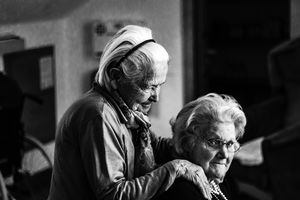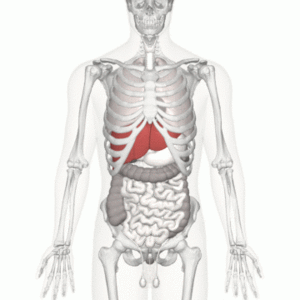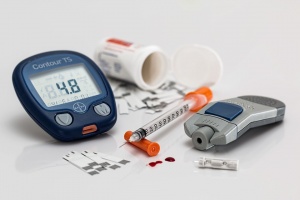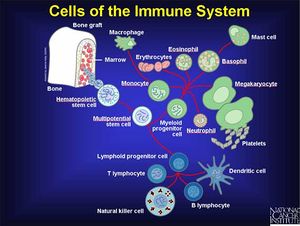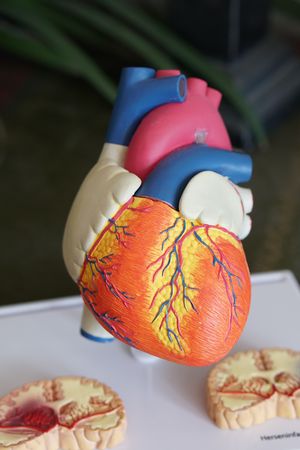Ageing and Changes in Other Systems: Difference between revisions
No edit summary |
m (Corrected referencing for website) |
||
| (14 intermediate revisions by 4 users not shown) | |||
| Line 7: | Line 7: | ||
== Introduction == | == Introduction == | ||
[[File:Nursing home.jpg|right|frameless]] | [[File:Nursing home.jpg|right|frameless]] | ||
Ageing is a complex process that involves a decline in biological functions and is accompanied by psychological, behavioural, and other changes. <ref>Khan SS, Singer BD, Vaughan DE. Molecular and physiological manifestations and measurement of aging in humans. Aging cell. 2017 Aug;16(4):624-33.</ref> | |||
All cells experience changes with ageing, becoming larger and less able to divide and multiply. There is an increase in pigments, and vital organs begin to lose some function as we age. Ageing changes occur in all of the body's cells, tissues, and organs, and these changes affect the functioning of all body systems. | |||
Some systems begin ageing as early as age 30, while other ageing processes are not common until much later in life. Unlike the changes of adolescence, which are predictable to within a few years, each person ages at a unique rate. Some signs of ageing can be seen from the outside, such as wrinkles and grey hair, while others are not visible.<ref>Britannica. Science & Tech. Available from:https://www.britannica.com/EBchecked/topic/1354293/human-aging. (Accessed 01/18/24)</ref> | |||
== Gastrointestinal System == | == Gastrointestinal System == | ||
Changes | [[File:Liver gif.gif|thumb]] | ||
* Loss of teeth, dental caries (tooth decay), gingival recession with problems adapting to dentures and altered bite | The gastrointestinal system extends from the mouth to the anus and includes the throat, esophagus, stomach, and intestines. Changes in Gastrointestinal system with ageing includes: | ||
* The aging process can have significant effects on the gastrointestinal system, including changes in appetite, atrophic changes in the jaw, mucosae, intestinal glands, and muscular layers, liver impairments, oesophageal reflux, ulcerations, and conditions such as diverticulosis, and constipation. | |||
* [[Liver Disease|Liver]] | * Loss of teeth, dental caries (tooth decay), gingival recession with problems adapting to dentures and altered bite can affect appetite. | ||
* | * [[Liver Disease|Liver]] impairments suspected in the older people can lead to [[Anorexia Nervosa|anorexia]], malnutrition, defective absorption of iron and vitamins e.g. [[Vitamin B12 Deficiency|B12]], and to pernicious anaemia or iron deficient [[anaemia]] through chronic blood loss. | ||
* | * With aging, the strength of oesophageal contractions decreases, and lactase levels decrease, leading to intolerance of dairy products by many older adults. | ||
* Gastrointestinal problems may lead to an altered [[Nutrition|nutritional]] status, so you will need to be aware of how much energy your treatment is using. | * Excessive growth of certain bacteria as a side effect of taking certain drugs can also cause diarrhea and poor absorption. | ||
* Alterations in gut function with aging have particular implications for oesophageal, gastric, and colonic motility, and older individuals are particularly susceptible to gastrointestinal disorders.<ref>Soenen S, Rayner CK, Jones KL, Horowitz M. The ageing gastrointestinal tract. Curr Opin Clin Nutr Metab Care. 2016 Jan;19(1):12-8. doi: 10.1097/MCO.0000000000000238. PMID: 26560524. | |||
</ref> | |||
* Gastrointestinal problems may lead to an altered [[Nutrition|nutritional]] status, so you will need to be aware of how much energy your treatment is using.<ref>Bhutto A, Morley JE. The clinical significance of gastrointestinal changes with aging. Curr Opin Clin Nutr Metab Care. 2008 Sep;11(5):651-60. doi: 10.1097/MCO.0b013e32830b5d37. PMID: 18685464. | |||
</ref> | |||
== Homeostasis == | == Homeostasis == | ||
The aging process can make individuals particularly vulnerable to plasma or [[Blood Physiology|blood]] loss, dehydration, [[Hypokalemia|potassium depletion]], and [[Arterial Blood Gases|metabolic acidosis]]. | |||
This vulnerability is due to the reduced capacity of the elderly to react to [[Stress and Health|stress]], as their ability to restore systemic equilibrium quickly when upset is impaired, and there is a breakdown in coordination because different organs age at different rates. | |||
This can lead to an altered nutritional status, making it important to be aware of the energy used during treatment.<ref>World Health Organization. Ageing and Health. Available from: https://www.who.int/news-room/fact-sheets/detail/ageing-and-health. (Accessed 01/18/24)</ref> | |||
== Endocrine System == | == Endocrine System == | ||
[[File:Diabetes-528678 960 720.jpg|right|frameless]] | [[File:Diabetes-528678 960 720.jpg|right|frameless]] | ||
The endocrine system undergoes significant changes with aging, which can affect hormone production and function. Some of the key changes in the endocrine system during aging include: | |||
# Decline in secretory capacity of pancreatic beta cells, leading to an increase in abnormal glucose tolerance. | |||
# Efficiency of insulin in dealing with excess glucose declines. | |||
# Functional thyroid activity declines with age. | |||
# Basal metabolic rate and radioactive iodine uptake fall. | |||
Clinical disorders | # Pituitary activity appears to be retained at normal levels with age, but adrenal activity is impaired. | ||
Clinical disorders associated with aging in the endocrine system include [[diabetes]], myxoedema (severe [[hypothyroidism]]), and thyrotoxicosis (the condition caused by excessive quantities of thyroid [[hormones]]).<ref>van den Beld AW, Kaufman JM, Zillikens MC, Lamberts SWJ, Egan JM, van der Lely AJ. The physiology of endocrine systems with ageing. Lancet Diabetes Endocrinol. 2018 Aug;6(8):647-658. doi: 10.1016/S2213-8587(18)30026-3. Epub 2018 Jul 17. PMID: 30017799; PMCID: PMC6089223</ref><ref>Chahal HS, Drake WM. The endocrine system and ageing. J Pathol. 2007 Jan;211(2):173-80. doi: 10.1002/path.2110. PMID: 17200939.</ref> | |||
Aging-induced effects on the endocrine system are difficult to disentangle from the influence of other factors, such as chronic diseases, inflammation, and low nutritional status, which can also affect endocrine systems. | |||
== Central | == Central Autonomic Dysfunction == | ||
Central autonomic dysfunction can lead to various symptoms and conditions, including [[Orthostatic Hypotension|postural hypotension]], impaired temperature control, the risk of hypothermia, loss of appreciation of visceral pain, and defective alimentary motility. | |||
This dysfunction can affect the autonomic nervous system (ANS), which controls basic functions such as heart rate, body temperature, breathing rate, digestion, and sensation. | |||
== Immune system == | == Immune system == | ||
The [[Immune System|immune system]] has the enormous task of recognizing self from non-self. While the immune system does not weaken with age, it becomes slower to respond, increasing the risk of getting sick. | |||
[[File:Cells of the immune system.jpg|right|frameless]] | [[File:Cells of the immune system.jpg|right|frameless]] | ||
Dysfunction in the immune system can accompany aging, which increases susceptibility to various diseases with different etiologies. Some of the changes in the immune system due to aging include: | |||
# Slower response: The immune system becomes slower to respond, increasing the risk of getting sick. | |||
# Increased vulnerability to infections: Levels of circulating antibodies begin to decline, leading to more frequent and severe infections in older individuals, such as pneumonia, influenza, and urinary tract infections. | |||
# Increased risk of cancer: The aging immune system loses the ability to protect against infections and cancer, which can contribute to the increasing incidence of tumorigenesis. | |||
# Chronic inflammation: Aging is associated with low-grade inflammation, which can contribute to age-related chronic diseases. | |||
It is essential to maintain a healthy lifestyle, including regular exercise, a balanced diet, and sufficient sleep, to support the immune system as it ages.<ref>Weyand, C. M., & Goronzy, J. J. (2016). Aging of the Immune System. Mechanisms and Therapeutic Targets. ''Annals of the American Thoracic Society'', ''13''(Suppl 5), S422. <nowiki>https://doi.org/10.1513/AnnalsATS.201602-095AW</nowiki></ref><ref>Montecino-Rodriguez, E., Berent-Maoz, B., & Dorshkind, K. (2013). Causes, consequences, and reversal of immune system aging. ''The Journal of Clinical Investigation'', ''123''(3), 958-965. <nowiki>https://doi.org/10.1172/JCI64096</nowiki></ref> | |||
== Aging and Cardiorespiratory System == | |||
[[File:Heart 3D.jpg|thumb]] | |||
Aging has a direct effect on the cardiorespiratory system, affecting the structure and function of the cardiovascular system. With aging, there is a gradual occurrence of hypertrophy of the heart, making it less responsive to sympathetic stimuli. This leads to a blunted exercise-induced heart rate rise and myocardial contractility. | |||
The physiologic changes that occur due to aging, such as increased stiffness of the arterial system, lead to left ventricle hypertrophy, increased afterload on the left ventricle, and an increase in systolic blood pressure. These age-related changes set the stage for isolated systemic hypertension, diastolic dysfunction, and heart failure.<ref>Heart Health and Aging | National Institute on Aging (nih.gov) Accessed from https://www.nia.nih.gov/health/heart-health/heart-health-and-aging on 11/1/24</ref> | |||
Changes in the respiratory system due to aging mainly involve: | |||
* Decrease in chest wall compliance | |||
* Respiratory muscle strength | |||
* Ventilatory response to hypoxia and hypercapnia | |||
* Sensation of dyspnea | |||
* Increase in air trapping and alveolar dead space<ref>North BJ, Sinclair DA. [https://www.ahajournals.org/doi/10.1161/circresaha.111.246876 The intersection between aging and cardiovascular disease]. Circulation research. 2012 Apr 13;110(8):1097-108.</ref> | |||
The | == Aging and Locomotor System == | ||
Research has proven that [[Ageing and the Locomotor System|locomotion]] is affected as the person advances his age. The muscles, bone and joints are affected as the person ages. The force production of lower limb muscles diminishes especially the calf muscles hence in compensation the proximal muscles such as that of the hip joint have to work more. There is a so-called distal to proximal shift in the joint power in old people while walking.<ref>Kulmala JP, Korhonen MT, Kuitunen S, Suominen H, Heinonen A, Mikkola A, Avela J. Which muscles compromise human locomotor performance with age?. Journal of the Royal Society interface. 2014 Nov 6;11(100):20140858.</ref>Studies have shown reduced long extensor muscle strength and tendon stiffness in aged individuals. | |||
There are various [[Postural Changes Affecting Voice Production|postural]] changes that occur as a person advances his age. The angle of thoracic kyphosis increases with age and it results in a hyperkyphotic curve. In compensation, the forward head posture is developed. It results in impaired cervical proprioception, vestibular deficits, and increased fall risk.<ref>Migliarese S, White E. Review of forward-head posture and vestibular deficits in older adults. Current Geriatrics Reports. 2019 Sep;8(3):194-201.</ref> | |||
[[Balance]] is also affected as a person ages. the sensorimotor function gets declined. The vision, cognition, strength, somatosensation and vestibular functions worsen.<ref>Wagner AR, Akinsola O, Chaudhari AM, Bigelow KE, Merfeld DM. Measuring vestibular contributions to age-related balance impairment: a review. Frontiers in neurology. 2021 Feb 9;12:635305.</ref> | |||
== | == References == | ||
<references /> | |||
[[Category:Older People/Geriatrics]] | [[Category:Older People/Geriatrics]] | ||
[[Category:Older People/Geriatrics - Assessment and Examination]] | [[Category:Older People/Geriatrics - Assessment and Examination]] | ||
[[Category:Balance]] | |||
[[Category:Vestibular System]] | |||
[[Category:Cardiovascular Disease]] | |||
[[Category:Gait]] | |||
Latest revision as of 19:18, 17 January 2024
Original Editor - Simisola Ajeyalemi
Top Contributors - Nupur Smit Shah, Simisola Ajeyalemi, Lucinda hampton, Vidya Acharya, Rucha Gadgil, Anisha Panchal, Mohit Chand, Kim Jackson, Shaimaa Eldib and Carina Therese Magtibay
Introduction[edit | edit source]
Ageing is a complex process that involves a decline in biological functions and is accompanied by psychological, behavioural, and other changes. [1]
All cells experience changes with ageing, becoming larger and less able to divide and multiply. There is an increase in pigments, and vital organs begin to lose some function as we age. Ageing changes occur in all of the body's cells, tissues, and organs, and these changes affect the functioning of all body systems.
Some systems begin ageing as early as age 30, while other ageing processes are not common until much later in life. Unlike the changes of adolescence, which are predictable to within a few years, each person ages at a unique rate. Some signs of ageing can be seen from the outside, such as wrinkles and grey hair, while others are not visible.[2]
Gastrointestinal System[edit | edit source]
The gastrointestinal system extends from the mouth to the anus and includes the throat, esophagus, stomach, and intestines. Changes in Gastrointestinal system with ageing includes:
- The aging process can have significant effects on the gastrointestinal system, including changes in appetite, atrophic changes in the jaw, mucosae, intestinal glands, and muscular layers, liver impairments, oesophageal reflux, ulcerations, and conditions such as diverticulosis, and constipation.
- Loss of teeth, dental caries (tooth decay), gingival recession with problems adapting to dentures and altered bite can affect appetite.
- Liver impairments suspected in the older people can lead to anorexia, malnutrition, defective absorption of iron and vitamins e.g. B12, and to pernicious anaemia or iron deficient anaemia through chronic blood loss.
- With aging, the strength of oesophageal contractions decreases, and lactase levels decrease, leading to intolerance of dairy products by many older adults.
- Excessive growth of certain bacteria as a side effect of taking certain drugs can also cause diarrhea and poor absorption.
- Alterations in gut function with aging have particular implications for oesophageal, gastric, and colonic motility, and older individuals are particularly susceptible to gastrointestinal disorders.[3]
- Gastrointestinal problems may lead to an altered nutritional status, so you will need to be aware of how much energy your treatment is using.[4]
Homeostasis[edit | edit source]
The aging process can make individuals particularly vulnerable to plasma or blood loss, dehydration, potassium depletion, and metabolic acidosis.
This vulnerability is due to the reduced capacity of the elderly to react to stress, as their ability to restore systemic equilibrium quickly when upset is impaired, and there is a breakdown in coordination because different organs age at different rates.
This can lead to an altered nutritional status, making it important to be aware of the energy used during treatment.[5]
Endocrine System[edit | edit source]
The endocrine system undergoes significant changes with aging, which can affect hormone production and function. Some of the key changes in the endocrine system during aging include:
- Decline in secretory capacity of pancreatic beta cells, leading to an increase in abnormal glucose tolerance.
- Efficiency of insulin in dealing with excess glucose declines.
- Functional thyroid activity declines with age.
- Basal metabolic rate and radioactive iodine uptake fall.
- Pituitary activity appears to be retained at normal levels with age, but adrenal activity is impaired.
Clinical disorders associated with aging in the endocrine system include diabetes, myxoedema (severe hypothyroidism), and thyrotoxicosis (the condition caused by excessive quantities of thyroid hormones).[6][7]
Aging-induced effects on the endocrine system are difficult to disentangle from the influence of other factors, such as chronic diseases, inflammation, and low nutritional status, which can also affect endocrine systems.
Central Autonomic Dysfunction[edit | edit source]
Central autonomic dysfunction can lead to various symptoms and conditions, including postural hypotension, impaired temperature control, the risk of hypothermia, loss of appreciation of visceral pain, and defective alimentary motility.
This dysfunction can affect the autonomic nervous system (ANS), which controls basic functions such as heart rate, body temperature, breathing rate, digestion, and sensation.
Immune system[edit | edit source]
The immune system has the enormous task of recognizing self from non-self. While the immune system does not weaken with age, it becomes slower to respond, increasing the risk of getting sick.
Dysfunction in the immune system can accompany aging, which increases susceptibility to various diseases with different etiologies. Some of the changes in the immune system due to aging include:
- Slower response: The immune system becomes slower to respond, increasing the risk of getting sick.
- Increased vulnerability to infections: Levels of circulating antibodies begin to decline, leading to more frequent and severe infections in older individuals, such as pneumonia, influenza, and urinary tract infections.
- Increased risk of cancer: The aging immune system loses the ability to protect against infections and cancer, which can contribute to the increasing incidence of tumorigenesis.
- Chronic inflammation: Aging is associated with low-grade inflammation, which can contribute to age-related chronic diseases.
It is essential to maintain a healthy lifestyle, including regular exercise, a balanced diet, and sufficient sleep, to support the immune system as it ages.[8][9]
Aging and Cardiorespiratory System[edit | edit source]
Aging has a direct effect on the cardiorespiratory system, affecting the structure and function of the cardiovascular system. With aging, there is a gradual occurrence of hypertrophy of the heart, making it less responsive to sympathetic stimuli. This leads to a blunted exercise-induced heart rate rise and myocardial contractility.
The physiologic changes that occur due to aging, such as increased stiffness of the arterial system, lead to left ventricle hypertrophy, increased afterload on the left ventricle, and an increase in systolic blood pressure. These age-related changes set the stage for isolated systemic hypertension, diastolic dysfunction, and heart failure.[10]
Changes in the respiratory system due to aging mainly involve:
- Decrease in chest wall compliance
- Respiratory muscle strength
- Ventilatory response to hypoxia and hypercapnia
- Sensation of dyspnea
- Increase in air trapping and alveolar dead space[11]
Aging and Locomotor System[edit | edit source]
Research has proven that locomotion is affected as the person advances his age. The muscles, bone and joints are affected as the person ages. The force production of lower limb muscles diminishes especially the calf muscles hence in compensation the proximal muscles such as that of the hip joint have to work more. There is a so-called distal to proximal shift in the joint power in old people while walking.[12]Studies have shown reduced long extensor muscle strength and tendon stiffness in aged individuals.
There are various postural changes that occur as a person advances his age. The angle of thoracic kyphosis increases with age and it results in a hyperkyphotic curve. In compensation, the forward head posture is developed. It results in impaired cervical proprioception, vestibular deficits, and increased fall risk.[13]
Balance is also affected as a person ages. the sensorimotor function gets declined. The vision, cognition, strength, somatosensation and vestibular functions worsen.[14]
References[edit | edit source]
- ↑ Khan SS, Singer BD, Vaughan DE. Molecular and physiological manifestations and measurement of aging in humans. Aging cell. 2017 Aug;16(4):624-33.
- ↑ Britannica. Science & Tech. Available from:https://www.britannica.com/EBchecked/topic/1354293/human-aging. (Accessed 01/18/24)
- ↑ Soenen S, Rayner CK, Jones KL, Horowitz M. The ageing gastrointestinal tract. Curr Opin Clin Nutr Metab Care. 2016 Jan;19(1):12-8. doi: 10.1097/MCO.0000000000000238. PMID: 26560524.
- ↑ Bhutto A, Morley JE. The clinical significance of gastrointestinal changes with aging. Curr Opin Clin Nutr Metab Care. 2008 Sep;11(5):651-60. doi: 10.1097/MCO.0b013e32830b5d37. PMID: 18685464.
- ↑ World Health Organization. Ageing and Health. Available from: https://www.who.int/news-room/fact-sheets/detail/ageing-and-health. (Accessed 01/18/24)
- ↑ van den Beld AW, Kaufman JM, Zillikens MC, Lamberts SWJ, Egan JM, van der Lely AJ. The physiology of endocrine systems with ageing. Lancet Diabetes Endocrinol. 2018 Aug;6(8):647-658. doi: 10.1016/S2213-8587(18)30026-3. Epub 2018 Jul 17. PMID: 30017799; PMCID: PMC6089223
- ↑ Chahal HS, Drake WM. The endocrine system and ageing. J Pathol. 2007 Jan;211(2):173-80. doi: 10.1002/path.2110. PMID: 17200939.
- ↑ Weyand, C. M., & Goronzy, J. J. (2016). Aging of the Immune System. Mechanisms and Therapeutic Targets. Annals of the American Thoracic Society, 13(Suppl 5), S422. https://doi.org/10.1513/AnnalsATS.201602-095AW
- ↑ Montecino-Rodriguez, E., Berent-Maoz, B., & Dorshkind, K. (2013). Causes, consequences, and reversal of immune system aging. The Journal of Clinical Investigation, 123(3), 958-965. https://doi.org/10.1172/JCI64096
- ↑ Heart Health and Aging | National Institute on Aging (nih.gov) Accessed from https://www.nia.nih.gov/health/heart-health/heart-health-and-aging on 11/1/24
- ↑ North BJ, Sinclair DA. The intersection between aging and cardiovascular disease. Circulation research. 2012 Apr 13;110(8):1097-108.
- ↑ Kulmala JP, Korhonen MT, Kuitunen S, Suominen H, Heinonen A, Mikkola A, Avela J. Which muscles compromise human locomotor performance with age?. Journal of the Royal Society interface. 2014 Nov 6;11(100):20140858.
- ↑ Migliarese S, White E. Review of forward-head posture and vestibular deficits in older adults. Current Geriatrics Reports. 2019 Sep;8(3):194-201.
- ↑ Wagner AR, Akinsola O, Chaudhari AM, Bigelow KE, Merfeld DM. Measuring vestibular contributions to age-related balance impairment: a review. Frontiers in neurology. 2021 Feb 9;12:635305.
